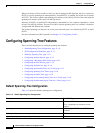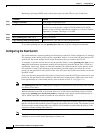
11-11
Catalyst 2940 Switch Software Configuration Guide
78-15507-02
Chapter 11 Configuring STP
Configuring Spanning-Tree Features
STP Configuration Guidelines
You can disable STP on one of the VLANs and then enable it on the VLAN where you want it to run.
Use the no spanning-tree vlan vlan-id global configuration command to disable spanning-tree on a
specific VLAN, and use the spanning-tree vlan vlan-id global configuration command to enable
spanning-tree on the desired VLAN.
Caution Switches that are not running spanning tree still forward BPDUs that they receive so that the other
switches on the VLAN that have a running spanning-tree instance can break loops. Therefore, spanning
tree must be running on enough switches to break all the loops in the network; for example, at least one
switch on each loop in the VLAN must be running spanning tree. It is not absolutely necessary to run
spanning tree on all switches in the VLAN; however, if you are running spanning tree only on a minimal
set of switches, an incautious change to the network that introduces another loop into the VLAN can
result in a broadcast storm.
Spanning-tree commands determine the configuration of VLAN spanning-tree instances. You create a
spanning-tree instance when you assign an interface to a VLAN. The spanning-tree instance is removed
when the last interface is moved to another VLAN. You can configure switch and port parameters before
a spanning-tree instance is created; these parameters are applied when the spanning-tree instance is
created.
Disabling Spanning Tree
Spanning-tree is enabled by default on VLAN 1 and on all newly created VLANs up to the spanning-tree
limit specified in the “Supported Spanning-Tree Instances” section on page 11-9. Disable STP only if
you are sure there are no loops in the network topology.
Caution When spanning tree is disabled and loops are present in the topology, excessive traffic and indefinite
packet duplication can drastically reduce network performance.
Spanning-tree port cost (configurable on a per-interface basis) 1000 Mbps: 4.
100 Mbps: 19.
10 Mbps: 100.
Spanning-tree VLAN port priority (configurable on a per-VLAN basis) 128.
Spanning-tree VLAN port cost (configurable on a per-VLAN basis) 1000 Mbps: 4.
100 Mbps: 19.
10 Mbps: 100.
Spanning-tree timers Hello time: 2 seconds.
Forward-delay time: 15 seconds.
Maximum-aging time: 20 seconds.
Table 11-3 Default Spanning-Tree Configuration (continued)
Feature Default Setting


















